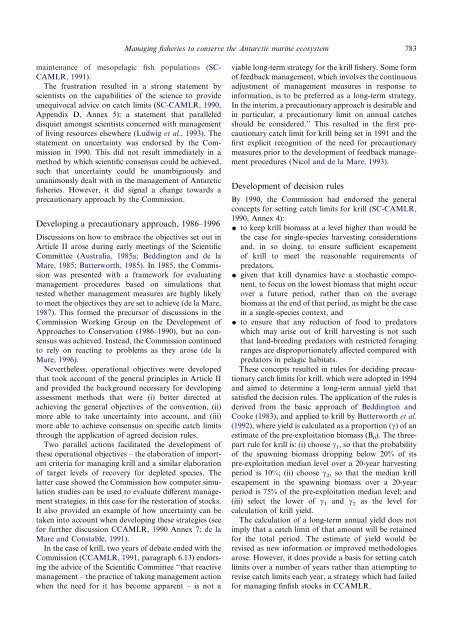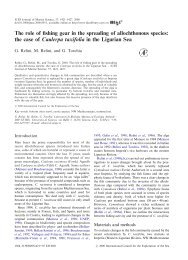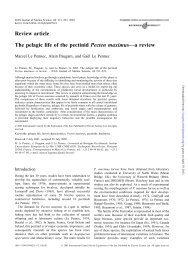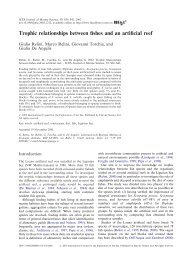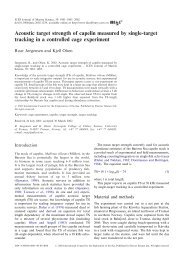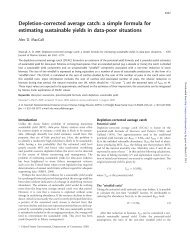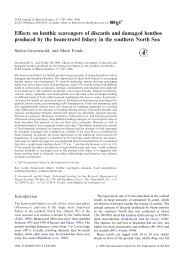Managing fisheries to conserve the Antarctic marine ecosystem ...
Managing fisheries to conserve the Antarctic marine ecosystem ...
Managing fisheries to conserve the Antarctic marine ecosystem ...
Create successful ePaper yourself
Turn your PDF publications into a flip-book with our unique Google optimized e-Paper software.
<strong>Managing</strong> <strong>fisheries</strong> <strong>to</strong> <strong>conserve</strong> <strong>the</strong> <strong>Antarctic</strong> <strong>marine</strong> <strong>ecosystem</strong><br />
783<br />
maintenance of mesopelagic fish populations (SC-<br />
CAMLR, 1991).<br />
The frustration resulted in a strong statement by<br />
scientists on <strong>the</strong> capabilities of <strong>the</strong> science <strong>to</strong> provide<br />
unequivocal advice on catch limits (SC-CAMLR, 1990,<br />
Appendix D, Annex 5); a statement that paralleled<br />
disquiet amongst scientists concerned with management<br />
of living resources elsewhere (Ludwig et al., 1993). The<br />
statement on uncertainty was endorsed by <strong>the</strong> Commission<br />
in 1990. This did not result immediately in a<br />
method by which scientific consensus could be achieved,<br />
such that uncertainty could be unambiguously and<br />
unanimously dealt with in <strong>the</strong> management of <strong>Antarctic</strong><br />
<strong>fisheries</strong>. However, it did signal a change <strong>to</strong>wards a<br />
precautionary approach by <strong>the</strong> Commission.<br />
Developing a precautionary approach, 1986–1996<br />
Discussions on how <strong>to</strong> embrace <strong>the</strong> objectives set out in<br />
Article II arose during early meetings of <strong>the</strong> Scientific<br />
Committee (Australia, 1985a; Bedding<strong>to</strong>n and de la<br />
Mare, 1985; Butterworth, 1985). In 1985, <strong>the</strong> Commission<br />
was presented with a framework for evaluating<br />
management procedures based on simulations that<br />
tested whe<strong>the</strong>r management measures are highly likely<br />
<strong>to</strong> meet <strong>the</strong> objectives <strong>the</strong>y are set <strong>to</strong> achieve (de la Mare,<br />
1987). This formed <strong>the</strong> precursor of discussions in <strong>the</strong><br />
Commission Working Group on <strong>the</strong> Development of<br />
Approaches <strong>to</strong> Conservation (1986–1990), but no consensus<br />
was achieved. Instead, <strong>the</strong> Commission continued<br />
<strong>to</strong> rely on reacting <strong>to</strong> problems as <strong>the</strong>y arose (de la<br />
Mare, 1996).<br />
Never<strong>the</strong>less, operational objectives were developed<br />
that <strong>to</strong>ok account of <strong>the</strong> general principles in Article II<br />
and provided <strong>the</strong> background necessary for developing<br />
assessment methods that were (i) better directed at<br />
achieving <strong>the</strong> general objectives of <strong>the</strong> convention, (ii)<br />
more able <strong>to</strong> take uncertainty in<strong>to</strong> account, and (iii)<br />
more able <strong>to</strong> achieve consensus on specific catch limits<br />
through <strong>the</strong> application of agreed decision rules.<br />
Two parallel actions facilitated <strong>the</strong> development of<br />
<strong>the</strong>se operational objectives – <strong>the</strong> elaboration of important<br />
criteria for managing krill and a similar elaboration<br />
of target levels of recovery for depleted species. The<br />
latter case showed <strong>the</strong> Commission how computer simulation<br />
studies can be used <strong>to</strong> evaluate different management<br />
strategies, in this case for <strong>the</strong> res<strong>to</strong>ration of s<strong>to</strong>cks.<br />
It also provided an example of how uncertainty can be<br />
taken in<strong>to</strong> account when developing <strong>the</strong>se strategies (see<br />
for fur<strong>the</strong>r discussion CCAMLR, 1990 Annex 7; de la<br />
Mare and Constable, 1991).<br />
In <strong>the</strong> case of krill, two years of debate ended with <strong>the</strong><br />
Commission (CCAMLR, 1991, paragraph 6.13) endorsing<br />
<strong>the</strong> advice of <strong>the</strong> Scientific Committee ‘‘that reactive<br />
management – <strong>the</strong> practice of taking management action<br />
when <strong>the</strong> need for it has become apparent – is not a<br />
viable long-term strategy for <strong>the</strong> krill fishery. Some form<br />
of feedback management, which involves <strong>the</strong> continuous<br />
adjustment of management measures in response <strong>to</strong><br />
information, is <strong>to</strong> be preferred as a long-term strategy.<br />
In <strong>the</strong> interim, a precautionary approach is desirable and<br />
in particular, a precautionary limit on annual catches<br />
should be considered.’’ This resulted in <strong>the</strong> first precautionary<br />
catch limit for krill being set in 1991 and <strong>the</strong><br />
first explicit recognition of <strong>the</strong> need for precautionary<br />
measures prior <strong>to</strong> <strong>the</strong> development of feedback management<br />
procedures (Nicol and de la Mare, 1993).<br />
Development of decision rules<br />
By 1990, <strong>the</strong> Commission had endorsed <strong>the</strong> general<br />
concepts for setting catch limits for krill (SC-CAMLR,<br />
1990, Annex 4):<br />
<strong>to</strong> keep krill biomass at a level higher than would be<br />
<strong>the</strong> case for single-species harvesting considerations<br />
and, in so doing, <strong>to</strong> ensure sufficient escapement<br />
of krill <strong>to</strong> meet <strong>the</strong> reasonable requirements of<br />
preda<strong>to</strong>rs,<br />
given that krill dynamics have a s<strong>to</strong>chastic component,<br />
<strong>to</strong> focus on <strong>the</strong> lowest biomass that might occur<br />
over a future period, ra<strong>the</strong>r than on <strong>the</strong> average<br />
biomass at <strong>the</strong> end of that period, as might be <strong>the</strong> case<br />
in a single-species context, and<br />
<br />
<strong>to</strong> ensure that any reduction of food <strong>to</strong> preda<strong>to</strong>rs<br />
which may arise out of krill harvesting is not such<br />
that land-breeding preda<strong>to</strong>rs with restricted foraging<br />
ranges are disproportionately affected compared with<br />
preda<strong>to</strong>rs in pelagic habitats.<br />
These concepts resulted in rules for deciding precautionary<br />
catch limits for krill, which were adopted in 1994<br />
and aimed <strong>to</strong> determine a long-term annual yield that<br />
satisfied <strong>the</strong> decision rules. The application of <strong>the</strong> rules is<br />
derived from <strong>the</strong> basic approach of Bedding<strong>to</strong>n and<br />
Cooke (1983), and applied <strong>to</strong> krill by Butterworth et al.<br />
(1992), where yield is calculated as a proportion (γ)ofan<br />
estimate of <strong>the</strong> pre-exploitation biomass (B 0 ). The threepart<br />
rule for krill is: (i) choose γ 1 , so that <strong>the</strong> probability<br />
of <strong>the</strong> spawning biomass dropping below 20% of its<br />
pre-exploitation median level over a 20-year harvesting<br />
period is 10%; (ii) choose γ 2 , so that <strong>the</strong> median krill<br />
escapement in <strong>the</strong> spawning biomass over a 20-year<br />
period is 75% of <strong>the</strong> pre-exploitation median level; and<br />
(iii) select <strong>the</strong> lower of γ 1 and γ 2 as <strong>the</strong> level for<br />
calculation of krill yield.<br />
The calculation of a long-term annual yield does not<br />
imply that a catch limit of that amount will be retained<br />
for <strong>the</strong> <strong>to</strong>tal period. The estimate of yield would be<br />
revised as new information or improved methodologies<br />
arose. However, it does provide a basis for setting catch<br />
limits over a number of years ra<strong>the</strong>r than attempting <strong>to</strong><br />
revise catch limits each year, a strategy which had failed<br />
for managing finfish s<strong>to</strong>cks in CCAMLR.


